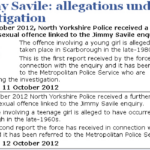HMICFRS Inspection triggers NYP misinformation offensive
by TIM HICKS
~~~~~
Introduction
The North Yorkshire Police (NYP) website exists for NYP to keep the public fully and openly informed of developments in policing in North Yorkshire. My attention was drawn to this article North Yorkshire Police statement on the recent HMIC Custody Inspection published on the NYP website. A transcript is below:
North Yorkshire Police statement on the recent HM Inspectorate of Constabulary and Fire & Rescue Services (HMICFRS) Custody Inspection
ACC [Assistant Chief Constable] Elliot Foskett said:
“We welcome the HMICFRS report, as it helps us to further understand how we can continue to improve our custody provision here in North Yorkshire Police.
Working within the legislative framework, our absolute priority is the safety and welfare of detainees, avoiding any adverse level of risk.
It is acknowledged that some processes, such as the recording of information, are not of the highest possible standard and this is something we have already started to look at.
We are pleased the HMICFRS has recognised we have good measures in place to oversee the safe and respectful provision of custody.
It’s also good to see the acknowledgement of the good work of our custody staff in relation to how they deal with detainees respectfully, patiently, and reassuringly, recognising the array of diverse needs.”
Only one sentence indicates that there were any deficiencies, giving the impression that there are some problems with paperwork, but otherwise all is perfect.
Background
The inspection was conducted jointly by HMICFRS, HM Inspectorate of Prisons and the Care Quality Commission (CQC) under a national rolling programme of custody inspections, which began in 2008, to ensure that custody facilities in all 43 forces in England and Wales are inspected regularly. It can be read in full here.
NYP has three custody suites based in York (24 cells), Harrogate (16 cells) and Scarborough (17 cells).
What the report actually says
I have worked as an auditor for many years and have a high opinion of the quality of HMICFRS inspections; both for their impartiality and attention to detail. This inspection was no exception. It was well done and makes shocking reading. It reveals the following deficiencies (extract):
- The quality of recording on custody records is often poor. Important information is sometimes missing, including the reasons for decisions such as the removal of clothing.
- Detention Officers complete digital person escort records for detainees who are attending court or recalled to prison, but some records had important information missing.
These deficiencies are disclosed in ACC Foskett’s statement above “some processes, such as the recording of information, are not of the highest possible standard”.
However the NYE team knows from long experience working with NYP’s press releases, it is what they do not mention that is important. ACC Foskett withheld from the above statement that the inspection also found (extract):
- The custody estate is dated and some facilities don’t meet detainee needs. There are potential ligature points in all of them, mainly due to the design of toilets and fit of doors.
- NYP knows the suite at York needs improvement and has included this on its risk register. However, there has been little investment in the custody estate since the last inspection in 2015, and some of those deficiencies remain.
- Staff weren’t always deployed in the most effective way, and it wasn’t always clear who was responsible for which tasks. This leads to delays in booking detainees into custody, and to late welfare checks.
- The force has adopted the College of Policing’s Authorised Professional Practice and its own policies and guidance. But doesn’t always follow them.
- There are quality assurance arrangements in place, but these aren’t always identifying concerns, and Chief Officers don’t use the findings to make improvements.
- Staff were over-stretched when the suites became busy.
- Custody Officers have little oversight of the release of these detainees.
- Female staff were not always on duty, which made it difficult to meet the needs of women and girls.
- There are often only three custody and detention staff members on duty. The staff work as a team to cover custody duties, but this sometimes means they carry out duties they shouldn’t be responsible for, or that are more suited to others. Custody Officers conducting cell checks and arousal visits instead of detention officers, and detention officers overseeing the release of detainees to court or prison when Custody Officers should do this. Arresting Officers escorted detainees to cells when detention Officers should do this. This sometimes leads to duplication in effort, and to responsibilities becoming blurred. In one case arousal checks of detainees under the influence of alcohol were not completed on time because it wasn’t clear who was supposed to be doing them.
- There isn’t always enough support for Officers when dealing with incidents involving people with mental health issues.
- Welfare checks aren’t always carried out on time.
- One day of continuous professional development training is provided. But if staff can’t attend the training because of annual leave or other commitments, no alternative arrangements were made for them to do it.
- NYP’s approach to training can lead to a lack of experienced officers in the suites, as several may be new in post at the same time.
- Staff felt that training could be better. There were gaps in staff knowledge, including of some basic custody processes. For example, not all custody officers were aware that they should visit and speak with the detainees in their care following the shift handover.
- Detainee dignity is generally protected, but some practices are disrespectful, particularly when detainee clothing is removed.
- Custody Officers generally set observation levels that reflect the risk posed, but this isn’t always the case for detainees under the influence of alcohol and/or drugs (who should be on 30-minute checks with arousals).
- Sometimes arresting Officers don’t explain the necessity and proportionality for detention (as required by PACE Code G) well enough.
- Some aspects of reviews of detention don’t meet the requirements of PACE Code C.
- There isn’t always prompt support for children and vulnerable detainees from an appropriate adult, to help them understand their rights, entitlements and other custody processes.
- Some CCTV monitors in the custody area can be seen by detainees or others in the suite.
- Shower locations and screens aren’t private enough, as they can be seen from corridors.
- Detainees can wait a long time if they need a Mental Health Act assessment in custody, and then often wait again for transfer to a mental health facility.
Cause of Concern 1
The Force’s governance and oversight of the use of force in custody isn’t good enough. Limited recording on custody records, a lack of use-of-force forms for incidents, and limitations in the way quality assurance is carried out means it doesn’t have accurate information to support effective scrutiny. Our CCTV review found incidents weren’t always managed well. The force can’t show that when force is used in custody it is always necessary, justified and proportionate.
Recommendation 1
The Force should scrutinise the use of force in custody to show that when force is used in custody, it is necessary, justified and proportionate. This scrutiny should be based on accurate information and robust quality assurance.
Cause of Concern 2
The management of risk isn’t good enough, and the Force isn’t always assuring detainee safety
-
- Custody Officers don’t triage queues to risk assess detainees for booking in.
- Detainees under the influence of alcohol and/or drugs aren’t always placed on level 2 observations with arousals.
- Checks on detainees are frequently carried out by different members of custody staff, making it difficult to assess changes in a detainee’s behaviour.
- Detainee welfare checks aren’t always on time, carried out properly, or recorded accurately.
- Level 4 (close proximity) watches aren’t always conducted or recorded in line with Authorised Professional Practice guidance. Bespoke briefings to officers aren’t recorded, and custody staff don’t carry out welfare checks or arousals of detainees on this level of observation.
- All custody staff routinely remove cords and footwear from detainees without an individualised risk assessment.
- Anti-rip clothing is used too often, sometimes without justification or rationale. It is sometimes removed by force, which can lead to an escalation in risk.
- Handovers between shifts aren’t attended by all custody staff, and staff taking over don’t always visit the detainees in their care.
- Not all custody staff carry personal-issue anti-ligature knives.
- Custody staff don’t always keep control of cell keys.
Many of these practices don’t follow APP guidance and place detainees at an increased risk of harm.”
Recommendation 2
The Force should take immediate action to mitigate the risks to detainees by making sure its risk management practices are safe, follow APP guidance, and are consistently carried out to the required standard”
The same concerns were raised both in the 2008 and 2015 HMICFRS Custody Inspections.
In summary, the report is highly critical and identifies two areas of concern, fifteen areas for improvement with sixty individual points of improvement across the full range of custody activities.
However, other than a vague and dismissive reference to the two reporting issues, ACC Foskett has withheld all of this from the public in his statement.
ACC Foskett states that custody staff deal with “detainees respectfully, patiently, and reassuringly, recognising the array of diverse needs”. In fact, this is one of the areas extensively criticised by the inspection and is a major point of failure:
“Areas for improvement
The Force should strengthen its approach to meeting the individual and diverse needs of detainees by:
-
- making adequate provision for detainees with disabilities;
- making sure female staff contact and engage with the women they are assigned to;
- using private telephone interpreting services at all points during detention where important information needs to be given or requested; and
- consistently asking detainees if they have religious needs, and meeting them by providing religious texts and items for the main faiths.”
- having satisfactory disposal arrangements for menstrual care products;
In summary, the impact of all these failures is that if a fifteen-year-old girl, possibly with mental health issues or under the influence of drugs or alcohol is brought into custody; she could undergo a terrible ordeal. If there is no female member of staff available, she will be strip searched by men, possibly unnecessarily. An inadequate risk assessment will be performed.
The provisions of PACE – which is there to protect her – will be ignored, so the necessity for detention, the proportionality and length of detention will not be explained to her. If she is menstruating there will be unsatisfactory arrangements for disposal of female hygiene products. She will also be denied prompt access to mental health assessment, the correct number of welfare visits or welfare visits from an appropriate adult. She will be forced to undress and shower while being visible to male custody officers and anyone else that is passing; CCTV surveillance of her in her cell will also be visible to anyone passing. If she is drunk, she may not be placed on observation or get arousal visits and may have excessive force applied to her.
If she is sick in her sleep, she may choke on her vomit and die, because she has not been aroused and the welfare observations were not performed. If she tries to commit suicide by hanging with a ligature from one of the ligature points in her cell, she will probably be successful, because custody staff do not perform the welfare observations and did not have ligature knives to cut off the ligature. Her detention will not be properly recorded, making it difficult to hold any Officer to account for incorrect actions such as the removal of clothing or being observed in the shower.
ACC Foskett’s statement describes this shocking state of affairs as “we have good measures in place to oversee the safe and respectful provision of custody.
The conclusion is inescapable that ACC Foskett appears to have deliberately misrepresented the inspection’s findings in his statement and covered up serious failings in NYP’s custody arrangements.
This is unacceptable for a Chief Police Officer in the 21st Century, serving in a Police Force which is supposed to be open and accountable.
ACC Foskett transferred to NYP in March 2022 from Northamptonshire Police. His official biography reveals that amongst his many impressive achievements he was the lead for wellbeing for Northamptonshire Police and working on the national gender working group. He designed and implemented the national ‘Aspire’ course, providing a bespoke course for those who identify as belonging to groups underrepresented in senior policing. In 2020 he took up the Northamptonshire Police Force-lead for diversity, equality and inclusion.
Obviously these are important milestones for the virtue signalling, woke, politically aware, good news only, career-orientated, PR conscious, smooth, articulate, media trained, PR professional that gets to the top in the Police Service nowadays. In this context, ACC Foskett seems to have got off to a flying start in his new role as a Chief Police Officer in NYP.
I have been covering NYP since 2011. Apart from the NYP statement that Jimmy Savile had no connections to North Yorkshire and the report by Deputy Chief Constable Sue Cross that there was no evidence of Jimmy Savile and Peter Jaconelli offending in North Yorkshire (in fact they had committed multiple rapes in Scarborough and Whitby with the full knowledge of NYP*). I am of the opinion that ACC Foskett’s statement is the biggest and most brazen piece of misinformation to come out of the back end of Force Headquarters in the history of policing in North Yorkshire.
I asked ACC Foskett for a portrait photograph 620 x 350 to illustrate this article, but he ignored my request. So the image below will have to do.

If he carries on like this, I predict ACC Foskett will have a long and successful career with NYP, rising to the rank of Chief Constable.
Right of Reply
NYP and Commissioner Metcalfe were provided with a draft of this article and invited to comment. NYP and Commissioner Metcalfe both used their joint policy of proscribing the NYE, to evade their duty to comment.
If you are mentioned in this article and do not agree with the views expressed in it, or if you wish to correct any factual inaccuracy, please let me know using the letters@nyenquirer.uk email address and your views and a correction will be published if appropriate.
*Both rapists were exposed by NYE investigations, not by NYP: Editor













